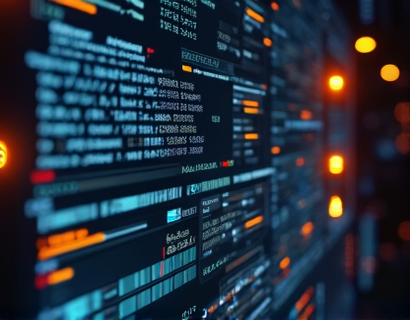Revolutionizing Finance: How AI and Crypto Drive Innovation in Digital Solutions
The intersection of artificial intelligence (AI) and cryptocurrency is igniting a transformative wave in the finance sector, redefining traditional concepts and opening unprecedented opportunities for digital innovation. This article delves into the profound impact of these technologies, exploring how their synergy is reshaping financial services and paving the way for a more efficient, secure, and accessible future in digital finance.
The Emergence of AI in Finance
Artificial intelligence has been gradually infiltrating various sectors, and finance is no exception. AI's ability to process vast amounts of data at unprecedented speeds and accuracy has made it an invaluable asset in the financial industry. Traditionally, financial institutions relied on manual processes and basic algorithms for tasks such as fraud detection, risk assessment, and customer service. However, AI has revolutionized these processes, introducing automation, predictive analytics, and personalized experiences.
One of the most significant contributions of AI in finance is in the realm of fraud detection. Machine learning algorithms can analyze patterns and anomalies in real-time, identifying potential fraudulent activities with high precision. This not only enhances security but also reduces the financial losses associated with fraud. AI-driven systems can adapt and learn from new data, continuously improving their detection capabilities.
Cryptocurrency: A New Paradigm in Digital Finance
Cryptocurrency, with its decentralized and transparent nature, has emerged as a disruptive force in the financial world. Unlike traditional currencies, cryptocurrencies operate on blockchain technology, a distributed ledger that ensures transparency and security. This technology underpins not only digital currencies but also smart contracts and decentralized applications (dApps), opening new avenues for financial innovation.
The adoption of cryptocurrencies has challenged the traditional banking system, offering an alternative for cross-border transactions, remittances, and financial inclusion. Cryptocurrencies reduce transaction costs and eliminate the need for intermediaries, making financial services more accessible to underserved populations. This democratization of finance is a significant step towards a more inclusive global economy.
AI and Crypto: A Powerful Synergy
The combination of AI and cryptocurrency creates a powerful synergy that is driving innovation in digital finance. AI enhances the functionality and security of cryptocurrencies, while cryptocurrencies provide a robust and transparent environment for AI algorithms to operate. This synergy is evident in several key areas:
- Enhanced Security: AI algorithms can monitor blockchain networks for suspicious activities, enhancing the security of cryptocurrency transactions. Machine learning models can detect and prevent fraudulent activities, such as double-spending and phishing attacks, ensuring a safer digital currency ecosystem.
- Improved Trading and Investment: AI-driven trading bots can analyze market data, identify trends, and execute trades with high precision and speed. These bots can operate 24/7, providing investors with a competitive edge. Additionally, AI can help in portfolio management, optimizing asset allocation and risk management based on real-time market conditions.
- Smart Contracts and Automation: AI can enhance the capabilities of smart contracts, making them more intelligent and adaptive. By integrating AI, smart contracts can execute complex logic and decision-making processes, automating various financial transactions and agreements. This reduces the need for intermediaries and speeds up transaction processing.
- Personalized Financial Services: AI can analyze user data to provide personalized financial advice and services. In the context of cryptocurrencies, AI can tailor recommendations for investments, wallet management, and security measures based on individual user preferences and behaviors.
Case Studies: Real-World Applications
The synergy between AI and cryptocurrency is not just theoretical; it is being implemented in various real-world scenarios. Here are a few notable examples:
1. Fraud Detection in Crypto Exchanges
A leading cryptocurrency exchange implemented an AI-powered fraud detection system that significantly reduced fraudulent transactions. The system analyzed transaction patterns and user behavior, flagging suspicious activities in real-time. This resulted in a 70% reduction in fraud-related losses, enhancing the overall security of the platform.
2. AI-Driven Trading Bots
A financial technology firm developed an AI-driven trading bot specifically for cryptocurrency markets. The bot uses machine learning algorithms to analyze historical data and real-time market conditions, making informed trading decisions. Users reported a 40% increase in trading efficiency and profitability, highlighting the potential of AI in enhancing trading strategies.
3. Smart Contract Optimization
An innovative startup integrated AI into its smart contract platform, enabling the creation of self-adjusting smart contracts. These contracts can modify their terms based on external factors such as market prices and user behavior. This flexibility reduces the risk of contract failures and ensures more reliable execution of agreements.
Challenges and Considerations
While the integration of AI and cryptocurrency offers numerous benefits, it also presents challenges that need to be addressed:
1. Regulatory Uncertainty
The regulatory landscape for cryptocurrencies is still evolving, and the use of AI adds another layer of complexity. Regulators are grappling with how to oversee AI-driven financial systems, ensuring compliance and protecting consumers. Clear and consistent regulations are essential to foster innovation while maintaining trust and security.
2. Data Privacy and Security
The extensive use of data in AI algorithms raises concerns about privacy and security. Ensuring that user data is handled ethically and securely is paramount. Implementing robust data protection measures and adhering to privacy regulations are critical steps in building trust in AI and cryptocurrency applications.
3. Technological Barriers
Not all financial institutions and individuals have the technical expertise to leverage AI and cryptocurrency effectively. Bridging the knowledge gap through education and accessible tools is necessary to widespread adoption. Collaborations between tech companies, financial institutions, and educational organizations can help demystify these technologies and promote their responsible use.
Future Prospects
The future of finance is increasingly intertwined with AI and cryptocurrency. As these technologies continue to mature, we can expect even more innovative applications and broader adoption. Here are some potential developments:
- Decentralized Finance (DeFi): AI can enhance DeFi platforms, making them more user-friendly and efficient. AI-driven risk assessment and automated lending systems can revolutionize access to financial services.
- Cross-Chain Interoperability: AI can facilitate seamless interactions between different blockchain networks, enabling more integrated and efficient financial ecosystems.
- Tokenized Assets: AI can optimize the management and trading of tokenized assets, providing new investment opportunities and enhancing liquidity.
In conclusion, the synergy between AI and cryptocurrency is transforming the financial landscape, offering unprecedented opportunities for innovation and efficiency. As these technologies continue to evolve, they will play a crucial role in shaping the future of digital finance, making it more secure, accessible, and user-centric.










































